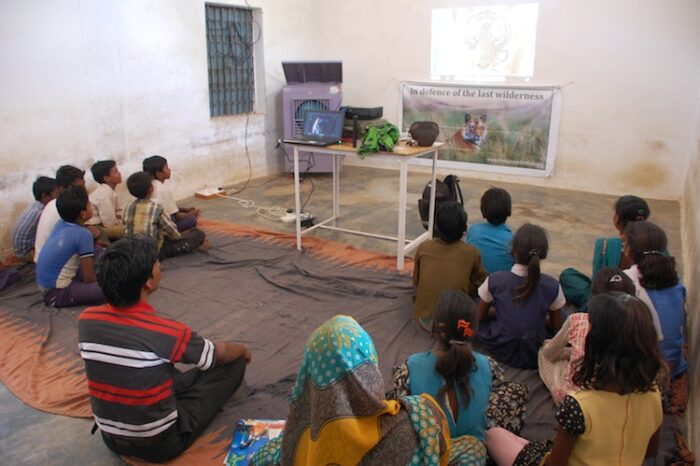To read the detailed report for this program, click here.
Apprehension and uncertainty played on our minds when we embarked upon a trip that could very well make it or break it as a starting point for our project. For we were going to interact with the children of Bandhavgarh Tiger Reserve on a yet to be set base of trust, understanding and most importantly ‘acceptance’ … acceptance of us in their domain as well as the faith and trust they needed to have in what we were going to talk to them about.
Bandhavgarh Tiger Reserve is a relatively small reserve flecked with several villages in both the core and the buffer zones of the park, thereby resulting in constant man-animal conflict as well as conflicts of the economical kind wherein these people of the forest have to rely on the bare minimum to sustain themselves in their daily fight to survive.
Therefore, it is essential to create an understanding among the people living here about the forest, its denizens and its existence (which is so crucial to mankind) so that together with the help of the existing communities we can hope to make a co-existence model between man and animal.
The objective of our project was to create awareness among children who are studying in the schools in the villages and to this effect we covered about 20 villages and 516 students. The session included taking these students to the park to understand the rich biodiversity existing in the park, screening of a movie to understand the lifecycle of a tiger along with the challenges faced in its survival and concluding it with the help of a presentation which would summarise what they had seen, heard during the day with a particular emphasis on the tiger’s importance to human beings what they could do to save the tiger as an added value add to their knowledge.
However, I must contradict myself here though by saying that these students added more to our knowledge than we could have ever thought of. Their knowledge about the flora was very impressive and these children had excellent observation skills (they spotted a rat snake also known as Dhaman in the local language on the forest leaf litter which my myopic vision had no hope of spotting), and were very curious and enthusiastic about everything they saw in the forest, right from the slightly hysterical peacocks (which we as tourists tend to take for granted and blatantly ignore) to the algae chewing Sambar to the slow moving Land Monitor Lizard (also known as ‘Goh’ or ‘Gohti’ in the local language), which they firmly believe is supremely venomous and gave us disbelieving looks when we told them otherwise.
The kids were forever ready to add their two penny worth about the things they saw especially on seeing the insectivorous bats in Badi Gufa, loudly proclaiming that that are lots of these ‘chimgaadads’ in the proximity of their villages, but much bigger than these. They were then told that the ones found in the village are probably the frugivorous ones as against the small insectivorous ones found in the caves.
Not surprisingly, owning to popular belief triggered by incidents of man-animal conflicts the tiger in these parts is viewed as a malicious blood-thirsty beast. Here, I literally mean blood-thirsty because people actually believe that tigers only drink the blood of their prey and leave the rest of the carcass to rot. However, this view was perhaps softened a little after we repeatedly told the students how human beings and cattle do not feature in the felines’ diet and if a tiger happens to attack man or cattle, it is because there is dearth of prey in the forest or that its home, the jungle, is being destroyed, which in turn is directly connected to our ruthless plundering for forest resources like wood and other NTFPs.
The ideology behind the tiger being a menacing beast is so deep rooted that we were not even expecting the students to give the tiger leeway or change their minds about its ‘blood-thirsty’ ways but it gave me a reason to hope when a small voice right at the back of the jeep (while on a safari ride) piped up, “If there is a tiger in the vicinity why are these Suraksha Shramik people (daily wage labourors, tending to weed in the Chakradhara meadows) on foot? Won’t the tiger attack them?” to which, his companion on the right replied, “Can’t you see so many deer in the meadow? Why should the tiger attack these people? It has plenty of food and cover to hide, it won’t attack!”
Just like that, in the blink of an eye, our fear of being accepted, of being trusted vanished, they were more evolved, more in tune with nature than we ever have been, and this we realised when we met Bharti a girl whose cousin had been attacked and killed by a tiger. She didn’t walk into the room with pre conceived notions about the tiger or mouth any ill will against it. She sat there, listened to us, added her views about why a tiger is important and vowed whole heartedly to save the tiger from extinction.
We often sideline these future custodians of the forest as being cruel, mindless beings (little realising their true value) but the truth is if we can’t involve these people in the need to conserve our natural heritage, the future for the tiger and all those connected, including us, looks very bleak.
